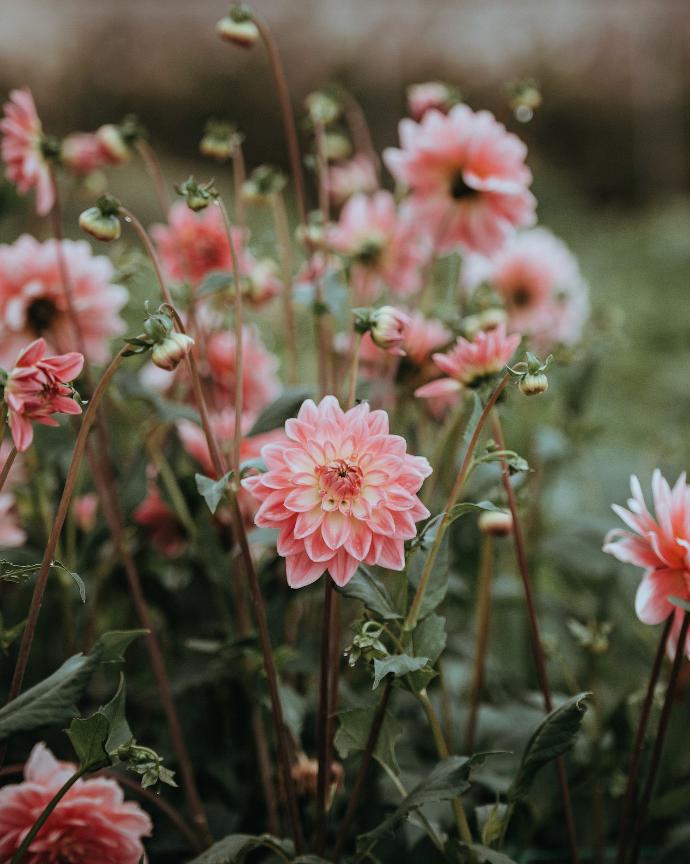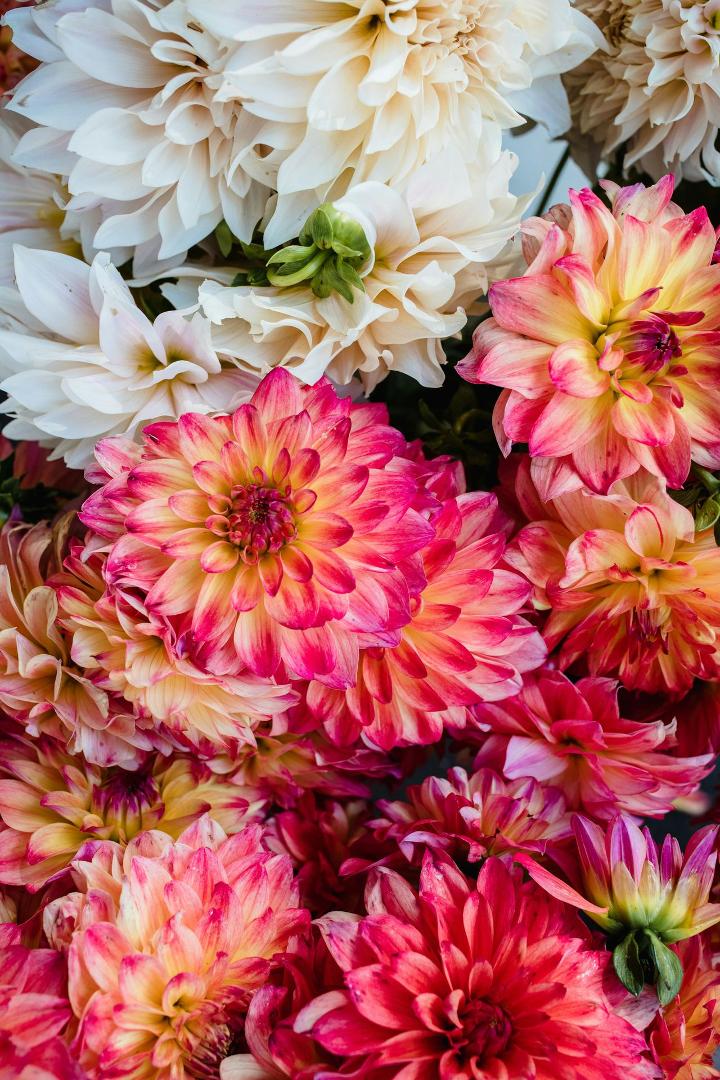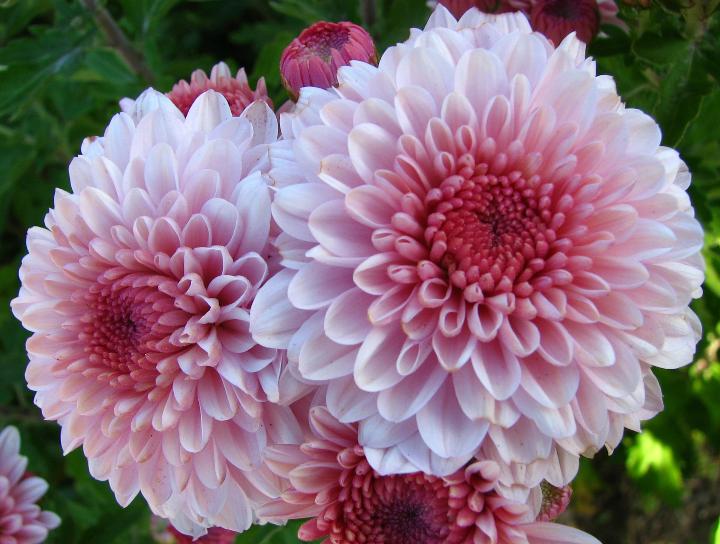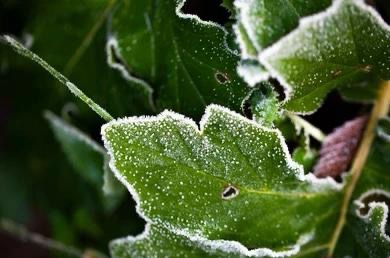Dahlia Plant
Dahlias, herbaceous perennials with fast growth, prefer well-drained soil and full sun. With moderate moisture needs, Dahlias are prized for their diverse and showy flowers, commonly grown in gardens and as cut flowers.

Habit
Herbaceous Perennial
Height
50 to 120 cm
Growth
Fast
Soil
Well-drained, sandy loam
Shade
Full Sun
Moisture
Moderate
Edible
No
Medicinal
No
Origin
Mexico
Climatic Condition
Temperate, warm
Temperature (°)
15 to 25
Humidity (%)
50 to 80
Potting media
Loamy soil mix
Fertilizers
High phosphorus, organic
Watering
Regular, deep watering
Plant Weight
200 to 400 g
Flowering Time
Summer to Fall
Soil Ph level
6.5 to 7.5
Water Ph level
6.0 to 7.5
Soil EC
0.4 to 1.2
Yield Per Plant
5 to 10 flowers per plant
NPK ratio
10:10:10
life Span
Annual
Health Benefits
Ornamental, attracts pollinators, used in floral arrangements.
Suggested Grow Media or Potting Mix ?
50% loamy soil, 30% compost, 20% sand
Suggested Fertigation/Fertilizers
Fertilize every 2 weeks with a balanced fertilizer.
Common Diseases and Remedies
powdery mildew
Whitish powdery spots on leaves and stunted growth and pale colour
spray 5% of neem oil
spray sulphur and copper fungicides like Bavistin , or Carbendizum @ 2g/lit water
HEALTH BENEFITS
- Rich in Inulin: Good for gut health and blood sugar control.
- Anti-Inflammatory Properties: May support immune function.
What Is An Dahlia Tree?
Dahlia is a perennial plant with tuberous roots. They come in all shapes and sizes, and come in a variety of colors, including white, yellow, orange, red, and purple. Dahlias are typically 2 to 3 feet tall and have simple, segmented leaves.
Dahlias continue to bloom from summer until frost. There are various types of dahlias, including the ``single dahlia,'' which has a single row of petals and blooms like a daisy, and the ``peony dahlia,'' which has two or more rows of petals.

What Are The Different Types Of Dahlia Plants?
1. Anemone dahlia
he flat petals are arranged in one row and are shaped like an anemone. Their colors are white, yellow, pink, orange, and red, and they measure 2 to 6 inches in diameter.
2. Baldahlia
Spherical or slightly flattened spherical. The petals may be blunt, rounded, or notched, and are usually arranged in a spiral.
3. Plate Dahlia
Large flowers 8 to 12 inches wide, usually with many layers of petals. Popular dahlia varieties used for plates include cafe au lait, Kelvin floodlight, and labyrinth.
4. Waterlily dahlias
Have saucer-like cupped petals that have a slight point. The flowers have a soft and delicate waterlily-like appearance.
5. Mignon dahlias
Are similar to single dahlias except their petal florets are rounded and their disc flowers have no more than two rows.

How to care for Dahlia Plants ?
1. Location
Dahlias grow best in a sunny, sheltered location with fertile, moist, well-drained soil.
2. Sunlight
Dahlias require a sunny, protected location.
3. Hydration
Dahlias prefer moist soil. In times of drought, water once a week with a mist rather than a gentle spray. If your dahlia is potted, water it frequently and daily during droughts.
4. Soil
Dahlias require fertile, moist, well-drained soil.
5. Nutrition
Dahlias respond well to fertilizers, but do not require much nitrogen. A 5-10-10 fertilizer mix, or one where the nitrogen content is about half the potassium and phosphorus content, is most effective.

6.Issues
Viral Diseases: Dahlias can suffer from a viral disease called Verticillium wilt, which is a fungal disease that lives in the soil.
Pests: Some garden pests feed on dahlia leaves, sometimes leaving the plants bare overnight.
What are the Benefits of Dahlia Plants ?
The roots of the dahlia plant are used as a dietary supplement, believed to have anti-inflammatory, antioxidant, and anti-diabetic properties. The roots are rich in inulin, a starch that can be converted to fructose, a sweetener that can be used in diabetic diets.Blood Sugar Control: Research has found that a molecule found in dahlia petals may help control blood sugar in people with type 2 diabetes and prediabetes.

FAQs About Growing Dahlia
1.What is special about daisy flower?
The sweet simplicity and genuine beauty of the daisy have made the flower an international emblem of innocence and purity.
2.Do daisies grow in India?
Yes, daisy seeds need full sunlight. The best temperature to grow daisy seeds is from 15° C to 23° C
3.What season do daisies grow?
Daisy Growing Season In India Daisies grow best in India during the cooler and mild winter season, typically from October to February.
4. 4.Is Daisy winter or summer flower?
English Daisy is a Winter season flower
5.Are daisies indoor flowers?
After the last frost in the spring, take your daisies back outside to enjoy its flowers in the spring and summer. Or you can keep your Gerbera daisy indoors in a cool, brightly lit spot

